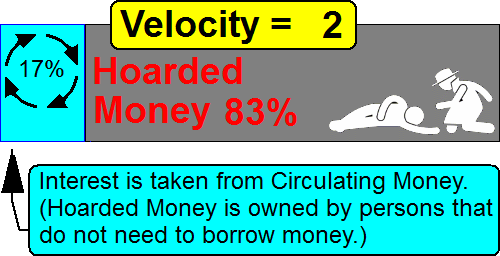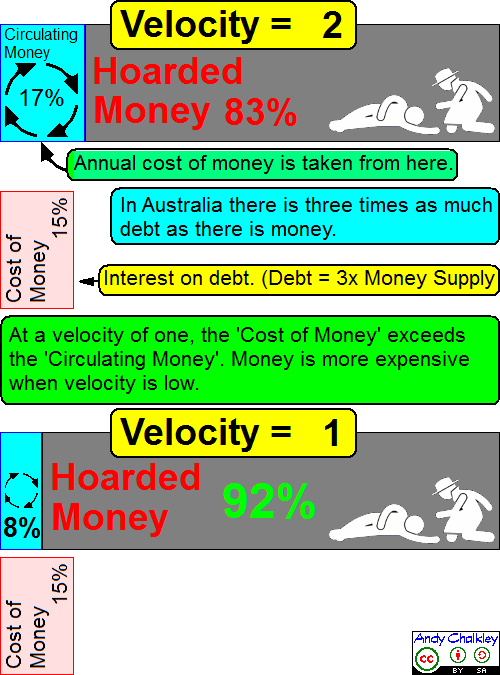
This is another branch of my reasoning. It costs money to borrow money. If we look at the Australian figures for an example. $67 billion has been created as cash currency by the Reserve Bank of Australia. There is $1760 billion listed as ‘Money Supply’ which has its existence as credit in bank accounts. One might assume that this money was borrowed into existence. This leads one to believe that the cost of money is the interest rate. However, the debt created during the creation of the $1760 billion has magnified with interest to a figure of $5400 billion. Thus, I argue that the cost of the $1760 billion is the interest on the $5400 billion. If we assume an average interest, including fees of 10%, the cost of money is a staggering 30% per annum. If we assume an average interest of 5%, we get a cost of money of 15%.
This is one of the problems with bank credit. Bank credit is incredibly expensive. For each $1000 in the Money Supply, there is a corresponding $3000 in debt being held by someone else. If interest rates are, say, 10%, we get the preposterous situation where: $1000 of bank credit in the Money Supply is costing someone else $300 in interest payments each year. Such is the lunacy of allowing persons to accumulate bank credit in bank accounts. If the prevailing interest rate is 5%, each $1000 in circulation is costing someone else $150.

We need to maintain a Money Supply or slightly increase the Money Supply. More particularly we need to maintain or increase the Circulating Money. On the above graph, maintenance of the Money Supply involves maintaining or increasing the green section. To constantly increase the volume of ‘green’ Bank Credit, there is a need to create new loans. New loans require new items on which to hang debt. The land is already divided up and debts hung on the land titles. Cars hold loans. Education is now on the list. It is becoming difficult to find more items on which to hang debt.
More than 95% of all money in circulation is the positive component of a loan. We are living on credit. Less than five percent of the money we use comes from a central bank. The €30 billion that the IMF lent to Greece did not come from the ECB. The person who has this Bank Credit against their name in a bank account is not paying the interest, but the person who took out the loan that created the Bank Credit is paying. Let us do some elementary mathematics. Let the interest rate be 10%. For each $1000 of Bank Credit in a bank account, someone else is servicing $3000 in debt. This $3000 accumulates $300 interest per annum. This is expensive money. If the interest rate was 5%, The interest would be $150:
Besides the expense of the current money system, there are other issues. The annual cost of money, which is between $150 and $300 per $1000, the expense is paid from those that do not hoard. The $150 is paid from Circulating Money, putting a downward pressure on the real economy. The situation gets worse when we consider Hoarded Money. If a nation has a velocity of two, then 83% of the money is hoarded. The ‘cost of money’ is equivalent to almost the entire Circulating Money section. Thus the constant need to increase debt.

The Circulating Money section in the diagram below furnishes almost all the tax to the government. This is because government tends to tax transactions and the result of transactions. Government avoids taxing Hoarded Money.

People with Hoarded Money tend not to borrow and so interest is paid from Circulating Money.

The next observation is that for each $1000 that is hoarded, someone is paying around $150 in interest for that Hoarded Money. Taking the logic further, the entire Hoarded Money comprising 83% of the Money Supply is costing 15% of 83%, which is devouring 12.45% of the Money Supply annually which is 73% of the Circulating Money annually. This effect is magnified with higher levels of hoarding (low velocity of money).
When velocity falls below about two, the cost of money can exceed the volume of Circulating Money. Although we can live with this, it makes the economy fragile. Minor downturns in the lending habits of banks or the borrowing activity of citizens can have dire consequences for the Circulating Money. The remedy is to decrease the proportion of Hoarded Money. However, the hoarders are remarkably good at holding on to their hoards and skilled at manipulating the tax system to preserve their money.

If Hoarded Money was eliminated, the cost of money would only be about 5% of the Circulating Money:
